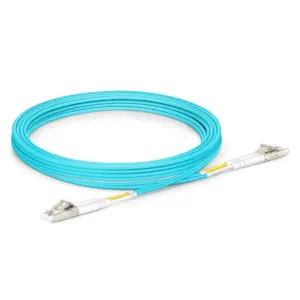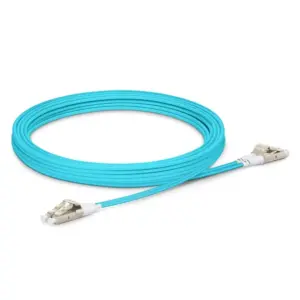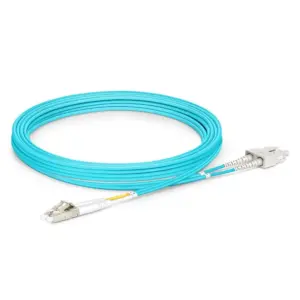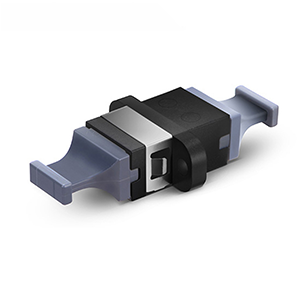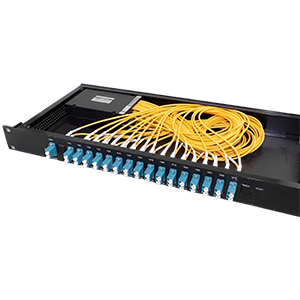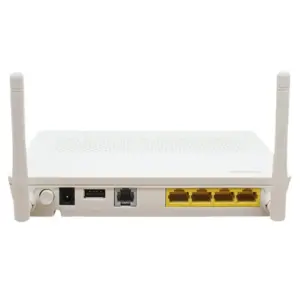Thank you very much for choosing to read this article. Today I will introduce to you OM3 optical fiber and its important role in optical fiber communication. As a multi-mode optical fiber solution, OM3 optical fiber has excellent performance in achieving high bandwidth requirements and short-distance transmission, and is widely used in enterprise networks, data centers, campus networks and other scenarios.
Overview of OM3 Fiber
OM3 optical fiber, as a multi-mode optical fiber solution, plays an important role in optical fiber communications. It is suitable for high-bandwidth transmission and short-distance transmission scenarios, and is especially important in applications such as data centers, local area networks, and storage area networks.
The role of OM3 optical fiber in optical fiber communication:
- High-bandwidth transmission: OM3 fiber has a relatively large core diameter and is able to accommodate multiple optical modes, so it can provide higher bandwidth. This makes OM3 fiber very useful in applications that require high-speed data transmission, such as data centers, local area networks (LANs), and storage area networks (SANs).
- Short-distance transmission: OM3 optical fiber is mainly suitable for short-distance transmission, usually within a range of 550 meters. It is capable of providing high-bandwidth transmission within this distance and is suitable for LAN and data center applications in most enterprises and organizations.
Features and performance of OM3 Fiber
OM3 optical fiber has some core features and performance parameters. The following is an introduction to them:
Core features:
- Transmission distance: OM3 optical fiber is suitable for short-distance transmission, usually within a range of 550 meters. This makes it ideal for applications such as data centers, local area networks, and storage area networks.
- Bandwidth: The core diameter of OM3 fiber is 50 microns, which can support the transmission of multiple optical modes. It is capable of providing high-bandwidth transmission, typically supporting 10 Gigabit Ethernet (10GbE) transmission rates.
- Rate: OM3 optical fiber supports high-speed data transmission. Common rates include 1 Gigabit Ethernet (1GbE), 10 Gigabit Ethernet (10GbE) and 40 Gigabit Ethernet (40GbE).
Performance parameters:
- Attenuation: Attenuation is the signal loss of optical signals during transmission. The attenuation of OM3 fiber is typically in the range of 0.5 to 3 decibels (dB) per kilometer at specific wavelengths. Lower attenuation indicates that the optical signal can maintain better signal strength over longer distances.
- Insertion Loss: Insertion loss refers to the attenuation of optical signals caused by a connector or connection point. The insertion loss of OM3 fiber is typically in the 0.3 to 0.5 dB range, which means there will be some signal loss when connecting fiber optic equipment.
- Bandwidth attenuation: Bandwidth attenuation means that the bandwidth of the signal gradually decreases as the transmission distance increases. The bandwidth attenuation of OM3 fiber is typically in the range of 0.7 to 2.7 MHz·km per kilometer at a specific wavelength.
In general, OM3 optical fiber has the characteristics of being suitable for short-distance transmission, providing high bandwidth and high-speed data transmission capabilities. Its performance parameters such as attenuation, insertion loss and bandwidth attenuation directly affect the transmission quality and distance of optical signals. Understanding these characteristics and performance parameters can help in the proper selection and use of OM3 fiber to meet specific fiber optic communications needs.
Application scenarios of OM3 Fiber
OM3 optical fiber is widely used in different application scenarios, especially in fields such as enterprise networks, data centers and campus networks. The following is a discussion of its application scenarios:
Corporate network:
- Local Area Network (LAN): OM3 optical fiber can be used to connect various network devices within the enterprise to achieve high-speed data transmission and quick response. It is suitable for large-scale data transmission, file sharing, video conferencing and multimedia applications.
- Enterprise cloud computing: As enterprises’ reliance on cloud computing continues to increase, OM3 fiber provides fast and reliable connections to support high-bandwidth communications between enterprises’ internal data centers and cloud service providers.
Data center:
- Server interconnection: In data centers, OM3 optical fiber is used to connect interconnections between servers to achieve high-speed data transmission and quick response. It supports complex computing tasks, applications such as virtualization and cloud computing.
- Storage system connection: OM3 optical fiber is used to connect the storage area network (SAN) between the storage device and the host. It can provide high-speed, reliable data transmission and support fast response and efficient data access of the storage system.
Campus network:
-Academic institutions: OM3 optical fiber is widely used in campus networks of universities and academic research institutions. It supports high-speed data transmission to meet the needs of academic research, online education and student services.- School data center: OM3 optical fiber plays a key role in school data centers, supporting key applications such as school management systems, library systems, video surveillance, and campus security.
OM3 optical fiber has obvious advantages in high bandwidth requirements and short-distance transmission:
- High bandwidth requirements: OM3 fiber provides a larger core diameter, enabling it to accommodate multiple optical modes, thereby enabling high-bandwidth transmission. It supports high-speed data transmission such as 10GbE and 40GbE, meeting the needs of modern enterprises and data centers for fast data transmission.
- Short-distance transmission: OM3 fiber is suitable for short-distance transmission, usually within a range of 550 meters. This makes it an ideal choice in scenarios such as data centers, enterprise networks, and campus networks, meeting the needs of applications such as local area networks and storage area networks.
All in all, OM3 optical fiber is widely used in application scenarios such as enterprise networks, data centers, and campus networks. Its advantage lies in meeting high bandwidth needs and short-distance transmission requirements, providing fast and reliable data transmission solutions for these fields.
Comparison of OM3 Fiber and other types of optical fibers
There are some differences in performance and applications between OM3 fiber and OM1 and OM2 fiber. Here’s a comparison of them, highlighting the advantages of OM3 fiber:
Performance comparison:
- Bandwidth: OM1 fiber has a bandwidth of 200 MHz·km, OM2 fiber has a bandwidth of 500 MHz·km, and OM3 fiber has a bandwidth of 2000 MHz·km. Therefore, OM3 fiber has greater bandwidth and supports higher-speed data transmission.
- Transmission distance: The transmission distance of OM1 fiber and OM2 fiber is usually 2 km, while the transmission distance of OM3 fiber can reach 550 m. Therefore, OM3 fiber is suitable for short-distance transmission, while OM1 and OM2 fiber are suitable for relatively short distances.
- Attenuation: The attenuation of OM1 fiber is usually 3.5 dB/km, the attenuation of OM2 fiber is usually 2.5 dB/km, and the attenuation of OM3 fiber is usually 0.5 dB/km. Therefore, OM3 fiber has lower attenuation and can achieve longer distance transmission.
Application comparison:
- OM1 optical fiber: Due to its lower bandwidth and larger attenuation, OM1 optical fiber is usually used for short-distance transmission, such as local area networks, connections inside buildings, etc.
- OM2 fiber: OM2 fiber has higher bandwidth and smaller attenuation than OM1 fiber. It is suitable for applications requiring medium-distance transmission and higher bandwidth, such as data centers and campus networks.
- OM3 optical fiber: OM3 optical fiber has larger bandwidth and lower attenuation, and is suitable for scenarios with high bandwidth requirements and short-distance transmission. It is widely used in areas such as data centers, enterprise networks, and campus networks that require fast and reliable data transmission.
Therefore, compared with OM1 and OM2 optical fibers, OM3 optical fibers have larger bandwidth and longer transmission distance. This makes OM3 fiber ideal for meeting high bandwidth needs and short-distance transmission requirements. It is widely used in scenarios such as data centers, enterprise networks, and campus networks, providing users with high-speed and reliable optical fiber communication solutions.
OM3 Fiber deployment and configuration recommendations
Here are some recommendations and best practices when deploying and configuring OM3 fiber:
Fiber optic cabling:
- Determine the cabling path: When planning fiber optic cabling, consider the transmission distance, location of connected devices, and network topology. Make sure wiring paths are short and direct to reduce optical signal attenuation and interference.
- Protect optical fibers: Optical fibers should avoid bends that are too small or too large, and need to be protected from physical damage and environmental interference. Use appropriate fiber optic cable protection sleeves and fiber management equipment to ensure the safety and reliability of fiber optic cabling.
Connect the device:
- Use compatible equipment: Make sure to use fiber optic transceivers, switches, routers and other network equipment that are compatible with OM3 fiber. This ensures interoperability and performance of fiber optic connections between devices.
- Pay attention to the device interface: choose the appropriate connection interface according to your needs, such as LC, SC or MPO, etc. Make sure the fiber optic connections have the same interface type so that the device can be connected correctly.
Connection method:
- Point-to-point connection: A direct point-to-point connection between a pair of devices is a common way. This connection method is suitable for scenarios that require direct communication between two devices.
- Fiber optic cross-connect: In large networks, fiber optic cross-connect can provide a more flexible connection method. Complex connection relationships and better management can be achieved by cross-connecting optical fibers between different devices to cross-connect panels or optical fiber jumper boxes.
Equipment selection and deployment strategy:
- High-performance devices: Choose devices with high performance and compatibility based on specific network needs. Consider factors such as bandwidth requirements, transmission distance, supported protocols, and device scalability.
- Redundancy and fault tolerance: In critical networks, consider using redundant equipment and links to ensure high availability and fault tolerance. This can include redundant fiber optic links and backup equipment.
When deploying OM3 fiber, it is recommended to work with the fiber supplier, network engineer or professional team to ensure correct cabling, equipment selection and configuration. They can provide more specific guidance and support based on specific network needs to achieve optimal fiber network performance and reliability.
Summarize:
In the future, with the development of emerging technologies and applications, such as 5G networks, cloud computing and the Internet of Things, OM3 Fiber will continue to play an important role in meeting growing network demands and providing higher bandwidth and reliability. The market prospect of OM3 optical fiber is very broad, and industry trends, competition landscape and market size all show its huge potential. We also provide some actual OM3 optical fiber application cases, demonstrating its successful application in different industries.
If you are interested in OM3 Fiber, please consider contacting us, we will provide you with professional advice and support to help you choose the OM3 fiber solution that suits your needs and achieve high-performance multi-mode fiber network connections.
- What does OM3 mean for fiber?
- What are OM1 OM2 OM3 OM4 OM5 fiber types?
- What is Fibre OM3 speeds?
- What is OM1 vs OM2 vs OM3 vs OM4 fiber?
- What is Om in fiber?
- Is OM3 single or multimode?
- What is OM1 and OM3?
- What is om 4 fiber?


